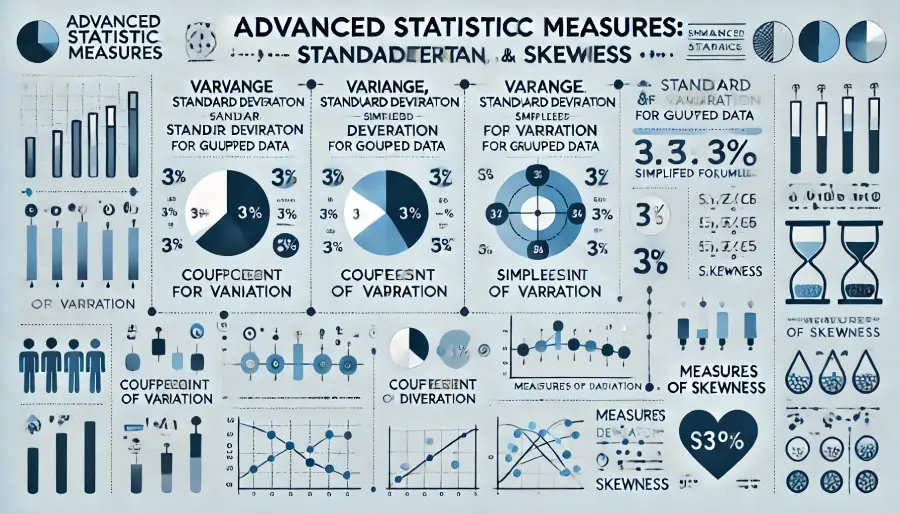- Variance and Standard Deviation for Grouped Data
- Explanation of variance for ungrouped and grouped data.
- Calculation methods and example.
- Coefficient of Variation \((CV)\)
- Definition and calculation.
- Example demonstrating its application.
- Simplified Formula for Variance
- A more convenient method for calculating variance.
- Mean Deviation
- Definition for both ungrouped and grouped data.
- Example calculation.
- Measures of Skewness
- Types of skewness (symmetric, positively skewed, negatively skewed).
- Coefficient of skewness calculation and example.
- Pearson’s skewness coefficient.
Variance and Standard Deviation for Grouped Data
Variance for Ungrouped Data:
For ungrouped data, the variance (\(\sigma^2\)) is calculated as:
\[ \sigma^2 = \frac{1}{N} \sum_{i=1}^N (x_i – \mu)^2 \]
where \(N\) is the total number of data points, \(x_i\) is each individual data point, and \(\mu\) is the mean of the data.
Variance for Grouped Data:
Assuming we have \(k\) groups with frequencies \(f_i\) and the central value of each group is \(w_i\), the variance of the population can be calculated as:
\[ \sigma^2 = \frac{1}{N} \sum_{i=1}^k f_i (w_i – \mu)^2 \]
where \(N\) is the sum of all frequencies.
The standard deviation (\(\sigma\)) is the square root of the variance:
For a Sample:
When dealing with a sample, replace \(\mu\) with the sample mean \((\bar{x})\), and the formula for variance becomes:
\[ s^2 = \frac{1}{n-1} \sum_{i=1}^k f_i (w_i – \bar{x})^2 \]
where \(n\) is the sample size.
Example Calculation
Consider an example where we have weights of 30 individuals classified into 5 groups:
| Class | Frequency \((f_i)\) | Central Value \((w_i)\) | Deviation from Mean \((\bar{x} – w_i)\) |
|---|---|---|---|
| 65-69 | 4 | 67.5 | -9.5 |
| 70-74 | 6 | 72.5 | -4.5 |
| 75-79 | 12 | 77.5 | 0.5 |
| 80-84 | 5 | 82.5 | 5.5 |
| 85-89 | 3 | 87.5 | 10.5 |
For variance \((s^2)\):
\[ s^2 = \frac{1}{29} \left[ 4(-9.5)^2 + 6(-4.5)^2 + 12(0.5)^2 + 5(5.5)^2 + 3(10.5)^2 \right] = 33.362 \]
The standard deviation \((s)\) is:
\[ s = \sqrt{33.362} \approx 5.776 \]
Coefficient of Variation (CV)
The coefficient of variation for the sample is given by:
\[ CV = \frac{s}{\bar{x}} \times 100 = \frac{5.776}{77} \times 100 \approx 7.50% \]
Simplified Formula for Variance
A more convenient formula for variance that does not require calculating deviations is:
\[ \sigma^2 = \frac{1}{N} \sum_{i=1}^k f_i w_i^2 – \mu^2 \]
For samples:
\[ s^2 = \frac{1}{n-1} \left( \sum_{i=1}^k f_i w_i^2 – n \bar{x}^2 \right) \]
Mean Deviation
For ungrouped data, mean deviation \((A)\) is calculated as:
\[ A = \frac{1}{N} \sum_{i=1}^N |x_i – \mu| \]
For grouped data:
\[ A = \frac{1}{N} \sum_{i=1}^k f_i |w_i – \mu| \]
Example for Mean Deviation:
Using the same weights example:
| Class | Frequency \((f_i)\) | Central Value \((w_i)\) | Deviation \((|\bar{x} – w_i|)\) |
|---|---|---|---|
| 65-69 | 4 | 67.5 | 9.5 |
| 70-74 | 6 | 72.5 | 4.5 |
| 75-79 | 12 | 77.5 | 0.5 |
| 80-84 | 5 | 82.5 | 5.5 |
| 85-89 | 3 | 87.5 | 10.5 |
Mean deviation \((A)\):
\[ A = \frac{1}{30} \left[ 4 \times 9.5 + 6 \times 4.5 + 12 \times 0.5 + 5 \times 5.5 + 3 \times 10.5 \right] = 4.333 \]
Measures of Skewness
Distributions can be symmetric, positively skewed, or negatively skewed.
Coefficient of Skewness \((\beta_1)\):
For a dataset \(x_1, x_2, \ldots, x_n\), the skewness coefficient is:
\[
\beta_1 = \frac{n \sum_{i=1}^n (x_i – \bar{x})^3}{(n-1)(n-2)s^3}
\]
Example Calculation:
For the data (1, 0, 1, 3, 5, 14):
\[ \bar{x} = 4 \]
\[ \beta_1 = \frac{6 \times 882}{5 \times (5.22)^3} = 1.036 \]
For grouped data, the skewness coefficient can be written as:
\[ \beta_1 = \frac{1}{n} \sum_{i=1}^k f_i \left( \frac{w_i – \bar{x}}{s} \right)^3 \]
Pearson’s Skewness Coefficient:
\[ \text{Pearson’s Skewness} = \frac{3(\bar{x} – \text{Median})}{s} \]
Key Takeaways
- Variance and standard deviation provide measures of dispersion for both grouped and ungrouped data.
- The coefficient of variation helps compare variability across different datasets.
- Skewness measures the asymmetry of data distributions, helping to understand the data’s shape relative to the mean.
This summary covers the main concepts and calculations related to variance, standard deviation, mean deviation, and skewness for grouped and ungrouped data.

